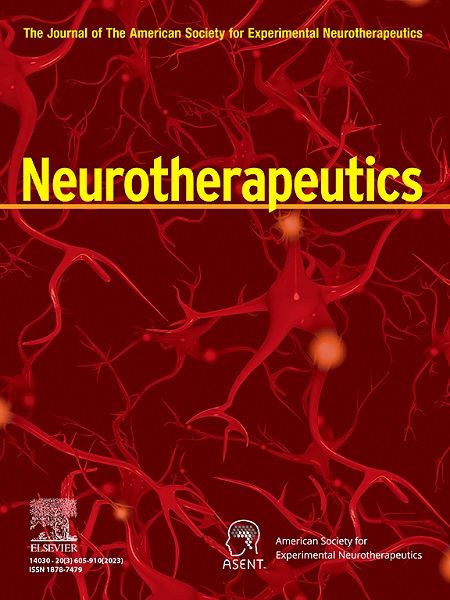Efficacy and safety of efavirenz in Niemann-Pick disease type C
IF 6.9
2区 医学
Q1 CLINICAL NEUROLOGY
引用次数: 0
Abstract
Introduction
In search of disease-modifying treatments for the Niemann-Pick disease type C (NPC), this Phase II single-arm clinical trial evaluated the safety and efficacy of efavirenz, a reverse transcriptase inhibitor that potentially ameliorates neuronal cholesterol turnover, typically impaired in this rare lysosomal storage disorder.
Material and methods
Patients 14 years of age or older with genetically confirmed NPC received efavirenz 25 mg/day (Weeks 1–26) or 100 mg/day (Weeks 27–52) orally on top of standard care including miglustat. The primary endpoint was the proportion of response, defined as lack of deterioration in a composite outcome of cognitive performance. Secondary endpoints included the quantitative scores of several clinical neuropsychological assessment tools, some relevant neurological signs and symptoms, and imaging and biological specimen-based biomarkers. Measures were taken repeatedly over time and were analyzed using generalized linear mixed models.
Results
Sixteen patients 15–60 years of age were enrolled. All (100.0 %, 95 % exact confidence interval: 79.4–100.0 %) met the primary endpoint response criterion at Week 52. Quantitative neuropsychological assessments yielded more nuanced results, with relative preservation of learning, memory and executive control, and subtle impairments of verbal fluency, selective and divided attention, and cognitive inhibition. Some patients had better responses than others, allowing us to set two well-differentiated subgroups that differed essentially in the time since symptoms onset. No efavirenz-related or serious adverse events were reported.
Conclusion
Efavirenz appears to be a safe, easy-to-use, new targeted therapeutic option which slows the rate of NPC progression. The benefits of efavirenz are greater if started earlier.
Trial Registration
Registered on the European Union Clinical Trials Register (EurdraCT) on December 20th, 2019 under the number: 2019-004498-18 (https://www.clinicaltrialsregister.eu/ctr-search/trial/2019-004498-18/ES/). The first patient was enrolled on May 25th, 2022.
依非韦伦治疗C型尼曼-皮克病的疗效和安全性。
为了寻找C型尼曼-皮克病(NPC)的疾病改善治疗方法,这项II期单组临床试验评估了依非韦伦的安全性和有效性。依非韦伦是一种逆转录酶抑制剂,可能改善这种罕见的溶酶体储存疾病中典型受损的神经元胆固醇转换。材料和方法:14岁或以上的遗传确诊鼻咽癌患者在标准治疗包括米卢司他的基础上口服依非韦伦25mg /天(第1-26周)或100mg /天(第27-52周)。主要终点是反应的比例,定义为认知表现的综合结果没有恶化。次要终点包括几种临床神经心理学评估工具的定量评分,一些相关的神经体征和症状,以及基于成像和生物标本的生物标志物。随着时间的推移反复采取措施,并使用广义线性混合模型进行分析。结果:16例15-60岁的患者入组。所有患者(100.0%,95%精确置信区间:79.4- 100.0%)在第52周达到主要终点缓解标准。定量的神经心理学评估得出了更微妙的结果,学习、记忆和执行控制相对保留,语言流畅性、选择性和分散注意力以及认知抑制的细微损害。一些患者比其他患者有更好的反应,允许我们设置两个分化良好的亚组,这些亚组在症状出现后的时间上存在本质上的差异。未见依非韦伦相关或严重不良事件的报道。结论:依非韦伦似乎是一种安全、易于使用、新的靶向治疗选择,可减缓鼻咽癌的进展速度。早期服用依非韦伦的好处更大。试验注册:于2019年12月20日在欧盟临床试验注册(eurdraft)上注册,编号:2019-004498-18 (https://www.clinicaltrialsregister.eu/ctr-search/trial/2019-004498-18/ES/)。第一位患者于2022年5月25日入组。
本文章由计算机程序翻译,如有差异,请以英文原文为准。
求助全文
约1分钟内获得全文
求助全文
来源期刊

Neurotherapeutics
医学-神经科学
CiteScore
11.00
自引率
3.50%
发文量
154
审稿时长
6-12 weeks
期刊介绍:
Neurotherapeutics® is the journal of the American Society for Experimental Neurotherapeutics (ASENT). Each issue provides critical reviews of an important topic relating to the treatment of neurological disorders written by international authorities.
The Journal also publishes original research articles in translational neuroscience including descriptions of cutting edge therapies that cross disciplinary lines and represent important contributions to neurotherapeutics for medical practitioners and other researchers in the field.
Neurotherapeutics ® delivers a multidisciplinary perspective on the frontiers of translational neuroscience, provides perspectives on current research and practice, and covers social and ethical as well as scientific issues.
 求助内容:
求助内容: 应助结果提醒方式:
应助结果提醒方式:


